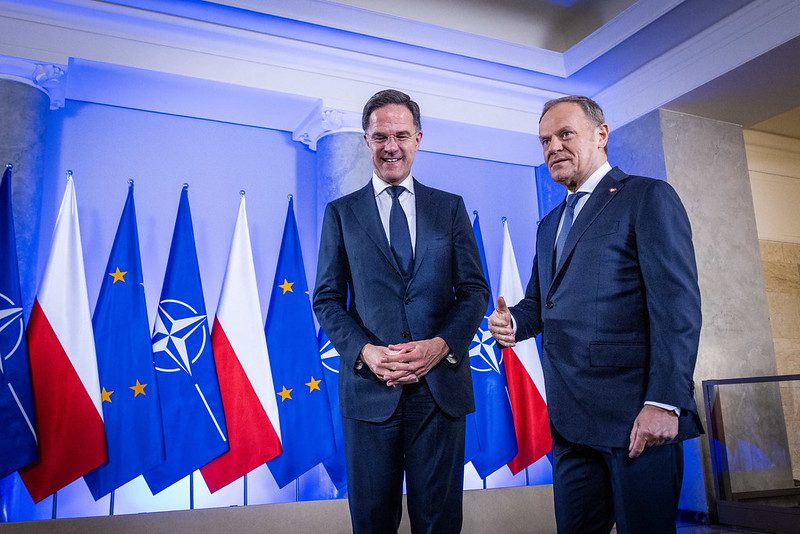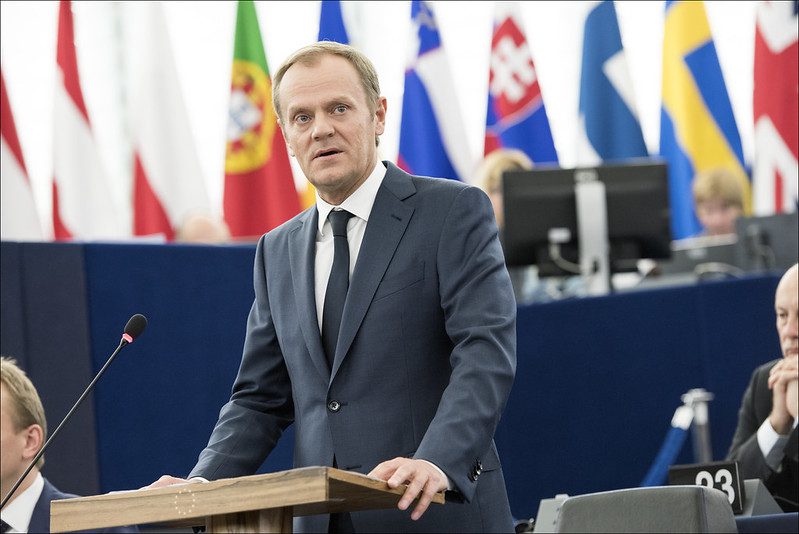At least 19 Russian drones crossed into Polish territory on Tuesday night, marking the first time Russian aerial targets were shot down inside the airspace of a NATO member state during Russia’s war in Ukraine.
Within hours of the incident, Prime Minister Donald Tusk convened Poland’s National Security Council and announced plans to invoke Article 4 of the NATO treaty, which allows member states to request consultations when their territorial integrity, security, or political independence is threatened.
Simultaneously, Russia launched a massive barrage on Ukraine involving roughly 415 drones and over 40 missiles – one of the heaviest bombardments of the war.
While Poland has previously endured occasional airspace violations, experts view Tuesday’s incursion as a deliberate provocation, intended to test NATO’s air-defence readiness and political will.
“Closest to open conflict since World War Two”
Addressing parliament, PM Donald Tusk remarked that the incursion marked a line that had been crossed, bringing Poland “nearer than ever to open conflict since the Second World War”, but adding there is “no reason to believe we’re on the brink of war”.
The country responded to the overnight incursions with what officials described as its most complex air-defence operation in decades. Within minutes of the first radar contacts, Polish F-16 fighter jets were scrambled from bases in Łask and Krzesiny. They were joined by Dutch F-35 stealth fighters deployed under NATO’s Baltic Air Policing mission, as well as Italian AWACS surveillance aircraft providing real-time tracking and target data. A NATO mid-air refuelling tanker orbited over central Poland to extend loiter times for allied jets, while German Patriot missile batteries on the ground stood ready to engage targets that slipped past the fighters.
Polish defence officials stressed that coordination was “seamless,” with allied command centers in Ramstein and Brussels feeding information directly to Polish crews. Analysts noted that it was the first time since the Cold War that such a broad mix of NATO aircraft, surveillance assets, and missile batteries had been mobilized simultaneously in Polish airspace.
At least three drones were confirmed shot down – with a fourth presumed destroyed – but officials cautioned the total could rise as search teams recovered debris from numerous crash sites. Polish outlets, citing military sources, described an all-night aerial engagement: drones flew at low altitude and arrived in waves, forcing pilots and air-defence crews to continually retask.
The scale of the threat also forced emergency measures on the ground. Several major airports – including Warsaw’s Chopin Airport and the strategically critical Rzeszów-Jasionka hub, used for military supplies to Ukraine – were shut for hours. Domestic flights were diverted or cancelled, and passengers spent much of the night sheltering inside terminals. In the eastern voivodeships, local authorities activated civil defence protocols, issuing mobile phone alerts that urged residents to remain indoors and avoid windows while unidentified aerial objects were being tracked overhead.
World condemns Russian aggression
NATO Secretary-General Mark Rutte called the violation “reckless” and confirmed that allied aircraft had engaged the drones under established defence procedures. He emphasised that NATO territory had been defended successfully and praised the rapid coordination between Polish and allied forces.

Image: NATO Secretary General Mark Rutte meets with the Prime Minister of Poland Donald Tusk – NATO
The incident prompted NATO to move additional aircraft and missile defence units to Poland. German Patriot systems already stationed in the country were placed on heightened readiness, while Britain, France, and the Netherlands confirmed they were considering further deployments of aircraft and ground-based systems.
Reaction across Europe was swift and unified. UK Prime Minister Keir Starmer called the incursion “egregious and unprecedented” and pledged full support for Poland. France’s President Emmanuel Macron urged the European Union to accelerate its joint defence initiatives.
Ukraine’s President Volodymyr Zelenskyy said the event underlined the need for stronger Western air defence support for Kyiv. He pointed out that Ukraine had intercepted more than 150 drones during the same attack, often with outdated equipment, and warned that continued Russian strikes against Ukraine inevitably risk drawing NATO directly into the conflict.
“US President Donald Trump also weighed in on Truth Social, writing: ‘What’s with Russia violating Poland’s airspace with drones? Here we go!’”
Moscow denies involvement
Moscow has denied targeting Poland, with Russia’s defence ministry insisting its “massive strike” was aimed only at Ukrainian territory and that “no targets on the territory of Poland were planned.” The Kremlin’s spokesman dismissed NATO’s accusations as baseless, claiming Poland had presented no proof the drones were Russian.

Image: Radoslaw Sikorski, Minister of Foreign Affairs of Poland – NATO
Polish officials flatly rejected Russia’s explanations. Foreign Minister Sikorski said the drones “did not veer off course” but deliberately targeted Polish territory, decrying Moscow’s “lies and denials” about the incident. Given the sheer number of incursions in one night, Polish and other European leaders argued it “defies imagination” that the violations could have been accidental.
Meanwhile, Belarus has acknowledged that several stray drones crossed into its territory overnight during the fighting between Russia and Ukraine. According to Minsk, its air defences shot down a number of them, and between 10 p.m. on September 9 and 4 a.m. on September 10, it also notified Polish and Lithuanian authorities that drones might enter their airspace as well. “It allowed Poland to promptly respond to actions of the drones by scrambling its own duty forces,” Belarusian Chief of the General Staff Pavel Muraveiko said.
The country, ruled for 31 years by strongman Alexander Lukashenko, remains under tight Russian influence however. Its military is effectively subordinate to Moscow, even though the country’s troops have not taken part directly in the war against Ukraine. In the early stages of the invasion, however, Belarus allowed its territory to be used for Russian attacks on Kyiv, though no further ground offensives have since been launched from there. Drones, on the other hand, almost certainly have. According to Polish sources, the drones crossing into Poland’s airspace also entered through Belarus. Minsk, for its part, has claimed these may have been drones launched from Russian territory that were targeting Ukraine but strayed into Polish airspace after passing through Belarus.
Ukrainian President Zelenskyy also warned that this was “another escalatory step” by Russia and “an extremely dangerous precedent for Europe.”
Wider implications for European security
The drone incursion into Poland carries consequences beyond the immediate military engagement. It raises questions about Moscow’s strategy and NATO’s deterrence posture.
For Russia, analysts suggest that the drones may have been intended to test NATO’s response times, radar coverage, and political resolve. By sending a large number of drones across the border, Moscow could measure how quickly NATO scrambled aircraft, how intercepts were coordinated, and how governments reacted. If so, the operation may have been as much about intelligence-gathering as intimidation.
For NATO, the drone incursion exposed critical vulnerabilities in air defence. Analysts warn that cheap, expendable drones can force NATO to deploy expensive aircraft and missile systems, exposing a costly asymmetry that demands urgent reform. This imbalance is driving pressure on European states to accelerate procurement of modern counter-drone systems and improve integration of national air-defences. The German-led European Sky Shield Initiative (ESSI), launched in 2022, is still evolving. However, the Polish incident reinforces arguments for expanding ESSI’s scope, enhancing EU-level funding, and achieving deeper alignment with NATO’s integrated air and missile defence architecture.
Diplomatically, the breach has hardened European attitudes. Even leaders previously hesitant to escalate support for Ukraine have condemned Russia’s actions in unequivocal terms. The sense that NATO territory itself is at risk may shift domestic debates in countries such as Germany and Italy, where military commitments have been politically sensitive.
The incident has renewed urgency around NATO’s deterrence strategy. While Article 5 – the alliance’s collective defence clause – was not triggered, the invocation of Article 4 highlights how close the alliance is to a crisis that could test its credibility. Should Russia repeat such incursions or cause casualties on NATO soil, the pressure to escalate could become unavoidable.
The attack also underscores Poland’s role as NATO’s frontline state. Warsaw has already invested heavily in defence, purchasing American F-35s, Abrams tanks, and South Korean artillery. Its government is expected to accelerate plans for further spending, particularly on missile and drone defences. Domestically, public opinion remains resolutely pro-NATO and sceptical of Russia, giving Warsaw broad political support for taking a hard line.
Featured Image via European Union 2015 – European Parliament




